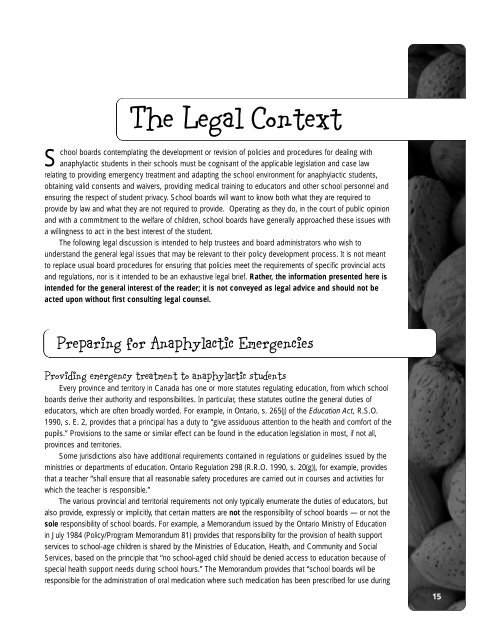Anaphylaxis - Canadian School Boards Association
Anaphylaxis - Canadian School Boards Association
Anaphylaxis - Canadian School Boards Association
Create successful ePaper yourself
Turn your PDF publications into a flip-book with our unique Google optimized e-Paper software.
The Legal Context<strong>School</strong> boards contemplating the development or revision of policies and procedures for dealing withanaphylactic students in their schools must be cognisant of the applicable legislation and case lawrelating to providing emergency treatment and adapting the school environment for anaphylactic students,obtaining valid consents and waivers, providing medical training to educators and other school personnel andensuring the respect of student privacy. <strong>School</strong> boards will want to know both what they are required toprovide by law and what they are not required to provide. Operating as they do, in the court of public opinionand with a commitment to the welfare of children, school boards have generally approached these issues witha willingness to act in the best interest of the student.The following legal discussion is intended to help trustees and board administrators who wish tounderstand the general legal issues that may be relevant to their policy development process. It is not meantto replace usual board procedures for ensuring that policies meet the requirements of specific provincial actsand regulations, nor is it intended to be an exhaustive legal brief. Rather, the information presented here isintended for the general interest of the reader; it is not conveyed as legal advice and should not beacted upon without first consulting legal counsel.Preparing for Anaphylactic EmergenciesProviding emergency treatment to anaphylactic studentsEvery province and territory in Canada has one or more statutes regulating education, from which schoolboards derive their authority and responsibilities. In particular, these statutes outline the general duties ofeducators, which are often broadly worded. For example, in Ontario, s. 265(j) of the Education Act, R.S.O.1990, s. E. 2, provides that a principal has a duty to “give assiduous attention to the health and comfort of thepupils.” Provisions to the same or similar effect can be found in the education legislation in most, if not all,provinces and territories.Some jurisdictions also have additional requirements contained in regulations or guidelines issued by theministries or departments of education. Ontario Regulation 298 (R.R.O. 1990, s. 20(g)), for example, providesthat a teacher “shall ensure that all reasonable safety procedures are carried out in courses and activities forwhich the teacher is responsible.”The various provincial and territorial requirements not only typically enumerate the duties of educators, butalso provide, expressly or implicitly, that certain matters are not the responsibility of school boards — or not thesole responsibility of school boards. For example, a Memorandum issued by the Ontario Ministry of Educationin July 1984 (Policy/Program Memorandum 81) provides that responsibility for the provision of health supportservices to school-age children is shared by the Ministries of Education, Health, and Community and SocialServices, based on the principle that “no school-aged child should be denied access to education because ofspecial health support needs during school hours.” The Memorandum provides that “school boards will beresponsible for the administration of oral medication where such medication has been prescribed for use during15


